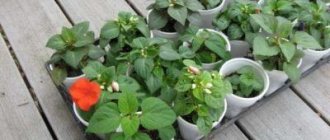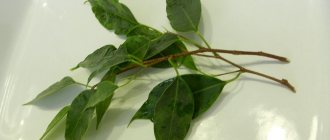- November 4, 2018
- Flowers
- Irina Tsirikhova
The Slavs have an ambivalent attitude towards ficus. Before the war, this plant was very popular, but after 1945, when many husbands did not return from the war, the ficus began to be credited with the properties of a “man expeller” that promotes separation.
However, the same thing happened at one time with the precious stone alexandrite. Its deposit was discovered shortly before 1812, and after the end of the war, many brides did not wait for their beloved ones, blaming it on alexandrite, and called it the “widow’s stone.” Therefore, with signs everything is not so clear. And yet, today this plant is very popular, so many people ask the question: “How to root ficus benjamina at home?” Let's discuss this.
Guarding clean air
Of the more than 1,000 species, the Benjamin ficus (Ficus benjamina) is very popular, apparently because this plant is considered an indoor air purifier. However, this happens for various reasons, including due to the relative unpretentiousness of this representative of the Tutov family. Ficus Benjamin belongs to the group of rubber plants, and it came to our latitudes from South Asia. This plant is also widespread in Australia and other countries with humid climates.
Our usual idea of this house plant is this: a medium-height tree, sometimes reaching 2 m, with bright green or variegated green glossy leaves, a small smooth trunk and a spreading crown.
However, in its natural habitat, for example, in India or China, this tree reaches very impressive sizes - up to 30 m, and the size of the leaves is significantly larger than those that we see on our ficus trees. But this requires a warm and humid climate. A dry climate has a detrimental effect on both the size and appearance of the Benjamin ficus.
Methods
Ficus benjamina is a unique plant that has the ability to quickly and efficiently purify indoor air. From the environment, the flower absorbs chemical compounds harmful to people: phenol, benzene, ethylene and others. After absorption, the smart plant breaks down these harmful substances in its body into amino acids and natural sugars.
To propagate a plant at home, you can use the following methods:
- seeds;
- cuttings;
- layering.
Let us immediately note that it is not customary to propagate this plant by seeds at home - the process is too long and complicated. Most gardeners choose the cutting method; sometimes layering is also used. Next, we will consider all of the listed methods in detail.
Care and concern
Before talking about propagating Ficus Benjamin, you need to familiarize yourself with the rules for caring for it. This is a guest from the tropics, and there is high humidity there. In addition, tropical forests do not receive direct rays of the sun. It is in such conditions that the ficus feels great.
Therefore, it is necessary to create for him in the house, if not the tropics, then something close to them. He will be very grateful to you for periodically spraying with water, but he will not be very happy if you start flooding his roots. In this case, it will react with the condition of the leaves, which will become covered with dark spots.
Features of reproduction
Instruments used to work with the plant must be sterile. To do this, the cutting part is treated with an alcohol solution or other antiseptic. If cuttings are taken from different bushes, then disinfection must be carried out after each flower. This will prevent infection of healthy flowers.
In the ground
For rooting in the ground, a substrate is prepared from turf soil, sand and peat. All components are disinfected in the oven by heating. After this, they are mixed and introduced into the planting container.
After cleaning the milky juice, the shoot is buried into the soil mixture by 2-3 buds. The soil is lightly compacted and moistened using a sprayer. To create a greenhouse effect, sticks are placed along the edges of the container, and a transparent plastic bag is fixed on top of them. The frame should be higher than the planting material. Successful rooting requires a warm environment and moderate humidity.
In water
Rooting cuttings in water is considered less troublesome. It is enough to place the blanks in a container with liquid. The container should not allow light to pass through, so when using a glass vessel, gardeners wrap the outer wall with foil or thick dark fabric. It is also necessary to build something similar to a greenhouse on top of the cuttings. The simplest option involves fixing a plastic cup.
When the cuttings are rooted in water, the microclimate is established close to the natural habitat conditions of ficus trees. This is a temperature within 25° and an average level of humidity.
Maintenance of an improvised greenhouse is kept to a minimum:
- 2-3 holes are made in the bottom of the plastic cup for free passage of air;
- As the water evaporates, make gravy;
- After the roots appear, the structure is dismantled for subsequent transplantation of the shoot.
Simple rules
Your concern should be moderate, without fanaticism, namely:
- in hot weather, spray the ficus more often, and at normal temperatures once a day is enough;
- bathe the plant about once a month in the shower;
- when the summer heat sets in, make sure that the soil in its pot is moist to at least 3 cm deep, but do not flood it; the first sign indicating that the ficus is thirsty will be yellow leaves and their falling off;
- the same sign indicates a temperature difference, lack of lighting or uncomfortable water for irrigation (cold);
- avoid drafts and temperature changes;
- Ficus Benjamin can withstand temperatures of at least 16 degrees;
- moisten and loosen the soil in a timely manner, but do not allow water to accumulate in the pan;
- monitor the condition of the plant trunk, and if you notice any curvature, turn the ficus with the other side towards the light;
- feed your green friend at least twice a month;
- if you replanted a ficus, take a break for feeding for 45 days;
- in winter there is no need for fertilizers;
- monitor the condition of the soil and its composition, taking into account that it should be different for young and adult plants.
Reproduction methods
How does ficus "Benjamina" propagate at home? Like most members of the family, ficus "Benjamina" can be propagated in the following ways:
By cuttings
From the top of the shoot, a cutting 15-17 centimeters in length is cut with a sharp knife. You need to cut the workpiece at an acute angle.
The best shoots are semi-lignified. Young, immature ones are not suitable.
Three sheets are left on the workpiece, the rest are removed. Shallow cuts are made on the cuttings to increase the rooting surface.
The next stage is getting rid of the milky juice. It quickly hardens and clogs the cut, through which the roots will not break through.
To prevent this from happening, the cuttings are placed in water and kept there for about 8 hours.
The water is changed every two to three hours. Then the workpiece is removed and dried.
The cut is treated with a composition to stimulate root formation.
Rooting should be carried out in a container with a layer of damp cotton wool on the bottom.
You can do this in warm water, but with this method there is a risk of rotting of the cuttings. To prevent this, you can add a little charcoal to the water.
Keep the planted workpiece in a lighted place, but keep it out of the sun - the cutting will wither in such conditions.
After 10-14 days you will see white roots emerging. Now the shoots of the ficus "Benjamina" can be planted in the soil.
The composition for planting cuttings with roots is as follows: leaf soil, peat, sand in equal parts.
You can root the cuttings in the soil substrate.
After removing the juice and drying, the workpiece is immersed in peat or in special soil for cacti for 2 buds , roots will appear near them.
For germination, it is necessary to create greenhouse conditions by covering the pot with a transparent cap.
The planting is ventilated so that the bottom of the workpiece does not rot. The substrate must be warm, it is advisable to warm it up artificially.
After 1.5-2 months, small leaves will appear on the workpiece. This indicates that the cutting has taken root.
But don't rush to open it. You need to accustom the sprout to air gradually, opening the greenhouse for more than a few hours a day.
By layering
The fastest way to obtain a full-fledged specimen with a height of 50-60 centimeters in a few months.
Layers are grown on the trunk of the ficus "Benjamina". From an area of 10-15 centimeters, located 60-70 centimeters below the crown, all leaves are cut off and the bark is cut out in a ring shape.
The cleaned area is moistened with root or heteroauxin, wrapped in moistened sphagnum moss and transparent plastic film.
The structure is fixed with wire or tape. To maintain moisture, use a syringe to add a little liquid under the film.
After 35-50 days, a powerful root system is formed on the trunk. The cuttings are cut from the main stem and planted in a separate pot.
At the same time, the growth of lateral shoots begins on the mother ficus, and it also does not lose its decorative effect.
From seeds
How to propagate ficus "Benjamina" at home from seeds?
This is the longest and most labor-intensive process. But flower growers claim that it is precisely this that will allow them to obtain the strongest, most viable and especially ornamental plant.
Ficus seeds do not ripen at home, since pollination does not occur indoors. Seeds must be purchased in specialty stores.
Before purchasing, make sure that the storage conditions for the goods are observed at the point of sale.
Ficus seeds are sensitive to changes in temperature and air humidity. There is a risk of purchasing material that is not suitable for planting.
Purchased seeds are disinfected in a weak solution of potassium permanganate and soaked for an hour in a growth stimulator.
Place drainage in a 2 cm , and pour soil on top of it.
The substrate for sowing is sterilized with steam for an hour.
Ready-made soil for ficus trees or a mixture of peat, sand and deciduous turf is suitable(1:1:1).
Moisten the soil before planting; this can be done by submersion.
A layer of soil 10-12 centimeters high is poured into a flat dish
The height of the soil should be 4-5 cm below the edge of the container.
Lightly tamp the substrate without compacting it too much, this will cause moisture stagnation.
Distribute the seeds evenly over the surface. They are very small, so use tweezers or the moistened tip of a stick to which the seed is glued to transfer it to the ground.
Sprinkle the seeds with a five millimeter layer of soil and moisten with a spray bottle.
Advice: when further moistening the crops, do not use a watering can - jets of water will wash away the soil and they will die. Moisturize by spraying.
The container is covered with glass or film and placed in a warm and bright place for germination.
Important: do not expose the dishes to direct sunlight - the seeds will die from overheating.
The best time for sowing is spring, when there is enough light. If ficus is sowed in autumn or winter, the seedlings will stretch out due to lack of light.
Glass from the dishes during the germination process is periodically (about twice a day for 10-15 minutes) removed for ventilation.
As soon as the seedlings appear, they must be hardened by removing the glass and leaving them in the open air for a short time at first. Gradually the time is increased.
After about a month and a half, the first true leaf appears at the seedlings. But don’t rush to pick up the sprouts right away. Do this after 3 months.
Make sure that the seedlings have enough light, otherwise they will become elongated and frail.
Important: when picking, make sure that the root collar does not go deep into the soil; it should remain at the same level as during germination. Ficus sprouts are planted in a separate pot when they reach a height of 10-15 cm.
From a sheet
This method is only called sheet.
In fact, for propagation it is necessary to cut off part of the stem with one leaf.
Only from such a preparation can a full-fledged plant with a trunk be obtained.
It is a mistake to believe that you can grow a new ficus from a leaf that has fallen off by accident or from drying out.
The leaf stalk is cut with a sharp knife with a piece of shoot about 5-6 cm.
The cut must be slightly split and placed in a glass of water for a day to drain the milky juice.
Additionally, you need to make small cuts on the cuttings - roots will sprout from them. Then the workpiece is placed in a root former solution for another day.
Important: the procedures are carried out in warm water and an air temperature of at least 20 degrees , otherwise the sheet will rot.
The prepared sheet is rolled into a tube and secured with an elastic band. The cutting is placed in the prepared substrate to the base of the leaf.
Advice: to prevent it from falling under the weight of its own, place a support stick next to it.
The planting is covered with a transparent cap to create greenhouse conditions and placed in a warm, well-lit place.
In about a month, a young ficus leaf will appear from the ground, this means that rooting has occurred successfully.
By following the rules of propagation, you will receive beautiful specimens of ficus “Benjamina” for interior decoration.
On new territory
So, you purchased a Ficus Benjamin and happily installed it in a pre-selected location. Of course, you have familiarized yourself with the desirable conditions of its detention.
Most likely, a store-bought pot is not durable and does not meet aesthetic requirements. You may want to replace the plastic pot with one of your choice. Take your time, because the ficus must go through an adaptation period of at least a month. Otherwise, he will shed his leaves in protest.
Please note: ficus benjamina is a very conservative plant and does not like change. Therefore, even if you fulfill all the conditions, this does not guarantee 100% success. But don’t despair, just wait it out calmly: after a while the plant will begin to come to life and settle into the new territory.
Remember that this picky dog does not like to be moved from place to place. Keep in mind that in its homeland, Ficus Benjamin is a very large tree that grows for decades in one place.
How to do it right
This ficus variety is quite easily propagated using cuttings. It is advisable to cut ficus in spring or early summer. For successful propagation, the cutting must be half woody, that is, still flexible, but no longer green (otherwise it will almost certainly rot and not take root).
To cut the shoots, use a sharp knife or blade, but not scissors - they can “soak” the edge, which will greatly slow down rooting.
Milky juice appears at the cut site. Whatever rooting method you choose, this juice must be washed off with water or wiped off with a napkin, otherwise it will try to heal the cut site, and this will make it difficult for the roots to grow. The lower leaves must be removed before planting. It is recommended to twist the upper ones and tie them with soft thread - this way the shoot will lose water more slowly.
If you want to grow new ficuses, and all the shoots of the mother plant are already quite woody, you can try making several longitudinal cuts from the cut point to make a “broom”. To prevent the parts from touching, you can insert matches between them.
First you need to prepare everything you need. Do not forget about disinfection of the products used.
Required materials and tools
In the process of preparing cuttings you will need:
- mother plant;
- container;
- filler;
- container with water;
- pruning shears or sharp knife;
- alcohol solution or other disinfectant;
- root stimulator.
It is easier to complete the work of harvesting and rooting cuttings if you follow this sequence.
- First stage. Select lignified or semi-lignified shoots on the mother plant, the length of which reaches 5-15 cm. They should have 2-3 nodes. You can take cuttings from both the top and side branches.
- Second phase. Make an incision with pruning shears under the lower bud. In this case, the pruning shears are installed at an angle of 45°. Cuttings should be treated with a product that activates the development of the root system (for example, Kornevin). This will speed up the rooting process.
- Third stage. To remove the milky juice released at the cut site, you need to place the cuttings in a container with warm water. Soak the workpieces in the liquid for an hour.
- Fourth stage. Fill the container with sand or a mixture of peat and perlite. Other fillers are also suitable: perlite, vermiculite, sphagnum moss. After lightly moistening, plant the cuttings in a container.
- Fifth stage. The container is covered with a glass jar or glass. The workpieces are kept in a warm room at a stable temperature of 25-26°. Periodically, the filler is slightly moistened. After 2-3 weeks, the cutting produces thin root shoots.
Time to change house
Changing the “place of residence” is stressful for Ficus Benjamin: he does not like sudden changes, especially if they contradict seasonal rhythms. Therefore, all relocations of this plant should be timed to coincide with spring. When replanting a ficus, keep in mind its age: a young plant will withstand such stress once a year, and an adult - once every 3 years. By the way, the plant becomes mature at 4 years.
It is necessary to change the house of the ficus not when you want, but only for certain indications:
- the plant has clearly outgrown the pot, and the roots do not fit into it;
- the soil has not been replaced for a long time;
- it's time to start propagating ficus;
- the soil dries out faster than usual;
- leaves turn yellow and fall off.
Important: the new pot should be about 3 cm larger than the old one. The bottom of the pot is covered with drainage; when replanting, do not destroy the earthen ball near the roots.
You can water the ficus no earlier than after 2 days, but this does not cancel regular spraying.
Cuttings
This is the most popular option in indoor floriculture. Propagation by cuttings does not require much time and is not too troublesome compared to other methods. In addition, cuttings from ficus in most cases leads to a successful result.
What time to choose
It is recommended to take cuttings from Ficus Benjamin in the spring. Early summer is also suitable - during this period the flower grows most actively. The choice of the spring-summer period is also justified by the fact that there is a lot of time before the cold weather: the ficus will have time to take root and strengthen properly.
Preparation of cuttings
The cutting must be cut from a healthy mother plant: usually the apical part is taken. The shoot size is 15 cm, its base should be semi-lignified. The cuttings should have from 4 to 6 leaves - fully expanded. A completely lignified cutting will not work, as it will not be able to produce roots: such a shoot can only be propagated by layering.
If there is no possibility or desire to touch the top of the donor plant, you can also acquire cuttings from a side shoot. The main thing is that the shoot has a leaf and a full-fledged axillary bud.
When cut, a milky juice is released, which must be blotted off immediately with a napkin. Then you need to cut off the leaves located below - when soaked in water they run the risk of rotting. Cuts must be made obliquely.
Important: cut cuttings only with a knife and not with scissors, as scissors can make the cut fringed, unsuitable for rooting, and prone to rotting.
Rooting
The roots of cuttings can be grown both in water and directly in the soil. If the first method is chosen, the cut part of the shoot is immersed by one third in settled water at room temperature. To prevent rotting from occurring, it is recommended to add an activated carbon tablet to the water. Place a jar of water on a well-lit windowsill, adding new water as it evaporates.
Choose an opaque container, as otherwise microorganisms will quickly begin to multiply in the water. Experienced gardeners, in order to control the process of root regrowth, place the ficus in a small transparent container, which in turn is placed in a large opaque one, also filled with water. The cutting is ready for rooting, the roots of which have grown by about 3 cm. This usually happens after a month.
Although root regrowth in water is practically guaranteed, when planted directly into the ground, the ficus root system turns out to be much stronger and more resilient. But the rooting itself occurs a little less often.
To root the cuttings in the ground, take a mixture consisting of:
- peat;
- ground charcoal;
- river sand.
Or you can purchase a ready-made substrate for ficus, sold in a flower shop. It is important that the soil is moist, but in moderation.
Being in water or in the ground, after 2-3 weeks under favorable conditions, the cutting takes root. To make the shoot take root faster, you can make several cuts on the lower part of the bark - thanks to such cuts, the plant reproduces much more readily, quickly releasing roots.
Make sure that the lower point of growth of the cutting is underground and not on its surface. And if you want roots to appear faster, build a mini-greenhouse by covering the top of the cutting with a plastic bag. From time to time, the polyethylene must be unwound so that the cutting can “breathe.”
Landing in a permanent place
After the roots have grown, the ficus seedling must be placed in a container with permeable, loose and nutritious soil. After planting, it is better to cover the plant with polyethylene for the first few days to create more favorable conditions for its adaptation. Remove the bag when new leaves appear on the seedling, indicating that the plant has taken root and the cuttings have been successfully completed.
Important: if the roots have grown long and become too long, it is recommended to cut them to about 3 cm before planting.
Reproduction of Ficus Benjamin
The step-by-step instructions for this painstaking process, called cuttings, are as follows:
- wait until the beginning of the season: ficus does not like controversial situations, so everything has its time;
- prepare a stationery knife or an ordinary garden knife, carry out the disinfection procedure;
- choose a suitable ficus stem, having previously decided on the length of the future cutting, which should be about 12 cm;
- cut off the selected part of the stem, taking the internode;
- Your cutting will have approximately 7 leaves. Tear off those closest to the cut;
- decide on the methods of planting the cuttings. To do this, evaluate its viability.
The first stage of propagation of Ficus Benjamin has been completed.
Seed propagation
This method is used less often than others, since it is quite tedious and very long.
It is usually customary to propagate ficus seeds only in breeding stations for scientific purposes - there is no need for such troubles at home. However, if you have free time and are determined to try growing ficus from seed, we will give some important instructions on this matter.
Before placing in the ground, the seeds must be treated with a growth stimulant - this way they will sprout more readily and quickly. Don’t forget about fungicides - it is important to protect plants from damage by pests and diseases.
Seeds are sown in light, nutritious and well-moistened soil. The container is placed in a warm place and covered with polyethylene on top. Thus, with constant ventilation and spraying of the soil, you should wait until the seeds germinate.
In the water or in the ground?
Ficus benjamina can be propagated in two ways: water and soil.
The first option is used if you are not sure that the root system is strong enough and will take root in the substrate. Or perhaps you just decided to play it safe, due to the fact that this is the first time you are propagating Ficus Benjamin from cuttings.
Then follow the instructions:
- prepare a small ceramic container with water at least 20 degrees;
- You will see white juice on the cut of the stem. You need to clear it from the ficus stem;
- lower the cuttings into a container of water so that the leaves do not come into contact with the water;
- choose a place so that it does not receive direct sunlight and there are no drafts;
- leave the container with the cutting there and do not disturb the plant for 2 weeks;
- after the specified period, check the cutting for the presence of the first roots;
- if you see sprouted roots, plant the cuttings in the ground;
- the first watering is after 2 days, and spraying is regular;
- wait about 10 more days, remembering to spray the cuttings.
Now examine the cutting: if you notice a new sprout next to it, you have succeeded, and you now know the answer to the question: “How to root Ficus Benjamin?”
Now let's move on to the description of the second method.
How to propagate ficus benjamina at home
I bought my first Benjamin after a major renovation in my apartment.
Everywhere there was a smell of either wallpaper, or glue, or laminate flooring, and the children were about to return from their grandmother. A friend recommended this particular plant - they say that ficus perfectly absorbs even formaldehyde, making the air cleaner. I bought the biggest one I saw in the store and placed it in the nursery. The smells really began to disappear. And when my sister started renovations, I “made” five pieces for her from my ficus in advance, for post-renovation “disinfection” of the space.
This beauty can be propagated in several ways.
The main thing is to have time to do this in the spring or in the first month of summer. These days, both the crown and the root system are growing especially actively, that is, the plant itself will “help” you.
Well, and of course, do not forget that you need to take cuttings only from a healthy plant, because after “circumcision” the ficus must have the strength to recover.
There are three ways to grow ficus (except cloning - but this is an industrial method that cannot be repeated at home).
By cuttings (so-called vegetative propagation)
This is the most popular way to grow a new ficus.
Important points when choosing a cutting:
- It is better to take green twigs rather than brown (woody) ones. You can take semi-lignified ones.
- They must be cut with a sharp knife (if you use dull scissors, they will only crumple the tissue, which is why the cutting may not germinate). It is customary to cut a branch at an angle.
- Don't cut too large a cutting. If it starts to sprout roots, they will turn out small and will not be able to “feed” a large cutting. A good size is 2-5 internodes, that is, no larger than 10 cm.
- You can also remove some of the leaves from the cuttings. Some people “kick off” the lower ones, others the largest ones. The essence of this procedure: this way the plant will evaporate less moisture, and the soil underneath will remain moist longer.
Many crops are propagated by leaf cuttings. But the leaves of the ficus benjamina do not let go of their roots.
Our next steps:
- Good soil for rooting: peat + sand, or coconut fiber, or wet sphagnum moss, or vermiculite (perlite). When caring for the “baby,” you can water it not just with water, but with a solution of a substance that helps plants take root.
- Before you start rooting, you need to wash off the sticky (milky) sap of the ficus, otherwise it will release from the “wound” on the cutting and begin to slow down rooting. This is done both under the tap and in a glass, in which the sprig is placed for 2 hours, then the water is changed - and so on several times (until you see that the juice no longer flows out). After this procedure, let the cutting lie on the table for several hours to dry.
- You can keep the cutting in fresh water longer (even several days or weeks, until the branch begins to grow roots - it all depends on the specific variety; variegated ficuses, such as Starlight, generally take up to a month to take root).
- The cutting itself takes root “with a creak”; it needs to be helped by organizing a small greenhouse. Simply put, tie the pot together with the cuttings in a transparent bag, covering it with a glass container. Yes, it’s not entirely aesthetically pleasing, but it’s cheap, reliable and practical.
By the way, a greenhouse can also be made from cut plastic bottles. It's more convenient than a package and costs pennies. Such a greenhouse looks like this:
The greenhouse can be kept on a warm heating pad or radiator (but not too hot, otherwise the soil will dry out too quickly, leaving the cuttings no chance to survive). Water the substrate from time to time (you can simply spray it), and ventilate the cuttings.
If you have rooted cuttings of many crops, then you know that a sign that the branch has taken root is new growing leaves. Ficus is a capricious “creature” and may not grow for some time, even after taking root.
But look at the leaves that were on it initially: if 10 days have passed after sticking the “stick” into the ground, and the leaves are still there and still turning green, everything worked out for you, the cutting has taken root.
When you see new leaves, do not remove the greenhouse immediately. It is necessary to gradually accustom the young plant to fresh air and normal room temperature, and only then release the plant “to freedom.”
To make the cutting take root faster, you can use modern floriculture chemistry. In this video they talk about Kornevin, and also show the real results of this drug. Well, what can I say - he definitely inspires trust!
But do not forget that products like “Kornevin” are considered moderately dangerous. Therefore, do not work with them in the kitchen or living room, wear gloves, and after use, wash and put your clothes in the wash.
Seeds
This method is very problematic, although I will not say that it is not feasible. It is often remembered by breeders who develop new hybrids and varieties.
If you nevertheless bought a bag of seeds, you need to proceed as follows:
- Soak the seeds in a solution of fungicide and growth stimulator.
- Sow on top of light, moist soil. Peat + sand will do.
- Make a small greenhouse over the seeds. It should be 26-30 degrees inside. You can use the same bag, a piece of glass, or a plastic bottle. Or, if you are very keen on indoor plant growing, you can look for special beautiful greenhouses for flowers in Ikea - they sell a set of as many as three pieces of different sizes.
- When the sprouts sprout, make sure that they stand in the light all the time, otherwise they will stretch out.
Lateral layering
This method is remembered in several cases: all the shoots on the plant have become woody (this Benjamin is reluctant to grow new branches), or you are growing a bonsai.
Everything is done like this:
- On a brown branch with thick bark, this very bark (without touching the inside, that is, the wood) is cut into a ring.
- The bare “body” of the ficus is treated with “Kornevin”.
- After this, the incision is wrapped with wet (lightly) sphagnum moss.
- Next, a ball of film is created. Thread, wire or electrical tape will help to fix it on the tree. The roots should appear 3-4 weeks later.
- When you see that the roots are visible through the film, the film and moss need to be removed, and the top of the ficus along with the young roots should be cut off.
- The cut area on both the old ficus and the new tree is rubbed with crushed charcoal (you can use pharmacy activated one) so that the plant does not get sick.
- Plant the young tree in light, nutritious soil.
You can see a positive example of such reproduction in this video. Yes, here the rubber-bearing ficus is used as a “model”, however, you need to do the same with Benjamin:
Source: https://sornyakov.net/komnatnye/fikus-bendzhamina-razmnozhenie.html
Landing in the ground
If you are a fairly experienced gardener, this is not the first time you have been replanting green pets, and you are sure that you know well how to propagate Ficus Benjamin at home - then go for it! This instruction is for you:
- make sure that you have purchased suitable soil for planting the cuttings;
- prepare a rooting agent for watering the cuttings, it can also be Hyley’s remedy;
- prepare a temporary pot for the cutting;
- prepare a plastic bottle or bag;
- clean the cutting from the white juice at the cutting site;
- leave the cutting for half an hour to dry the cut;
- place the cutting in the ground;
- water the cuttings with rooting agent;
- cover with a bag or bottle;
- do not disturb the plant for about 5 weeks;
- check the cutting for new shoots;
- then care for the plant for a while, and then transplant it into a new pot;
- See transplant rules above.
Thus, you are familiar with two methods of propagating ficus benjamina at home using cuttings. Let's move on to other options.
How to accelerate growth?
The main factors for the rapid growth of young ficuses are good lighting, high air temperature and humidity. The plant should feel like it is in its natural environment - in the tropics. The atmosphere in the room, which for humans, as a rule, feels stuffy, is most comfortable for ficus trees.
Important! The plant also needs to be provided with adequate nutrition. Complex fertilizing is applied starting from the 30th day after transplanting the rooted cuttings into the soil. Then the procedure is repeated every 14 days until the end of September.
Experts and experienced gardeners recommend the following fertilizers:
- Ideal;
- Rainbow;
- Pokon Ficus;
- Kemira.
By following all the recommendations for propagation and creating ideal conditions for seedlings, in 2-3 months the gardener will receive a fully developed specimen of Ficus Benjamin.
Spoiler
- https://sadovnikam.ru/428471a-fikus-bendjamina-razmnojenie-sposobyi-ukoreneniya-vyiraschivanie-osobennosti-uhoda-i-foto
- https://selo.live/2019/12/22/%D0%BA%D0%B0%D0%BA-%D1%80%D0%B0%D0%B7%D0%BC%D0%BD%D0% BE%D0%B6%D0%B8%D1%82%D1%8C-%D1%84%D0%B8%D0%BA%D1%83%D1%81-%D0%B1%D0%B5%D0% BD%D0%B4%D0%B6%D0%B0%D0%BC%D0%B8%D0%BD%D0%B0-%D0%B2-%D0%B4%D0%BE%D0%BC/
- https://JLady.ru/priroda/fikus-bendzhamina-razmnozhenie.html
- https://cemicvet.mediasole.ru/razmnozhenie_fikusa_bendzhamina_v_domashnih_usloviyah_cherenkami_i_ne_tolko
- https://ufermer.com/komnatnye-rasteniya/fikus/kak-razmnozhit-v-domashnih-usloviyah.html
Excellent(0)Bad(0)
Other ways
Now let's discuss how to propagate Ficus Benjamin in other ways.
There are two of them: the first is air layering, and the second is propagation of ficus by seeds. It should be noted that the second method is the most costly both in time and effort. However, it is he who is the least reliable.
As for air layering, it is carried out as follows: the prepared stem is cleared of leaves in the place where the locations of future cuts are planned. Next, we make cuts, with 2 or 3 cm between them. After this, we expose the bark between the cuts by stripping and cover it with damp moss, and on top with plastic film. We monitor the moisture content of the moss for two months. When the roots grow through the bag, you can cut the stem. The cutting location should be below the roots.
Then the stem is placed in the ground, and you are the happy owner of a new ficus Benjamin seedling.
Reproduction by layering
Ficus benjamina can reproduce not only by cuttings, but also by layering. This type of reproduction is used in the following situations:
- the plant rarely forms young shoots, but lignified adult stems are abundant;
- there is a desire to get a ficus bonsai with many aerial roots (layers) hanging from the shoots.
On a lignified shoot or branch without touching the wood, a ring-shaped cut is made on the bark. It needs to be treated with a growth stimulator and wrapped in damp sphagnum moss, which is covered with film. The latter is fixed with thread, tape or wire.
It is necessary to disconnect the cuttings from the mother plant only after the roots have formed. It must be cut below the root system. Further planting of the young seedling is carried out according to the traditional scheme. The cut on an adult flower that remains after removing the cuttings should be sprinkled with ground coal or treated with garden pitch.
This method is more complicated than the previous one, but is also quite applicable. Layerings are called ordinary aerial roots. The method is indispensable if the ficus is old, completely lignified and not suitable for cuttings.
On the lignified shoot of the mother plant, you need to cut the bark in the shape of a ring (see photo). Cut carefully to avoid damaging the wood too deeply.
The bark-free area of the plant is treated with a root stimulator and covered with peat, moss or peat soil mixture soaked in water. All this is fixed with a waterproof transparent film and secured firmly.
Moisten the moss/peat periodically to create favorable conditions for root germination. Usually, two months pass from the moment the bark is cut until the shoot is ready for planting.
Sprouted roots can be seen directly through the film. When this happens, the shoot with roots is separated from the mother plant and planted in a separate pot. Don't forget to treat the cut on the donor plant with activated charcoal or charcoal. It can also be treated with garden varnish.
Interesting: the method of propagating ficus by layering is used by bonsai specialists to obtain miniature trees of unusual shapes.
How to care
Let's find out what kind of care needs to be provided to the young Ficus Benjamin.
In order for the plant to please with its active development and healthy appearance, maintain a warm temperature in the room: the range should be from +25 to +28 degrees. In winter, +15 degrees will be enough. Ficus should be grown in a place inaccessible to the penetration of aggressive direct rays of the sun.
Regular watering must be ensured; drought and flooding of the soil should not be allowed. In addition to watering, you should also spray the young plant with a spray bottle - especially if it is summer heat outside or the air in the apartment is dry due to working batteries. But moisten the soil only after its top layer has noticeably dried out, not before.
Periodically wipe the ficus leaves with a damp cloth/sponge, since dust cannot be removed by spraying. Once a week, it is advisable to bathe the ficus in the shower: this procedure will simultaneously moisturize the plant and wash away dust and dirt from its leaves.
An important aspect of care is feeding the plant. Apply fertilizers according to the standard scheme, using complex compositions for ficus plants.
The plant will also need replanting. This procedure is usually carried out in the spring, each time choosing a slightly larger pot for the plant.
The plant is susceptible to pest attacks. Typically, misfortunes occur due to non-compliance with care requirements, as well as due to too dry air in the room. If the air is dry, ficus often acquires the following parasites:
- spider mite;
- thrips;
- scale insects, etc.
To avoid infection, spray the plant regularly.











